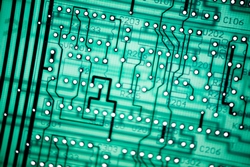We live in a technological age. Everything from your computer to your TV remote features ‘drop-down’ menus, through which you scroll and then press the ‘select’ button or whatever. Even resetting the digital clock in the family car requires an instruction manual. With cameras, the digital revolution has brought us the dreaded drop-down menu as well, plus other claimed advances.
These claimed advances include super little plastic bits called ‘memory chips’, onto which you store hundreds of your photos, to download to your computer when you feel inclined, and print even later. No more need to carry film canisters that store the negative film with a measly 36 images on each one. Hooray for technology!

However, is it quite as good as it is cracked up to be? There was a communication that had been written to the Bangkok Post, in which the letter writer was pointing out the fact that when he used to travel he would take 12 rolls of print film with him, which gave him a minimum of 432 frames. This needed the power of one fully charged NiCad battery and he was set up for the trip.
But technology has arrived, film is old hat, and now he needs three memory chips to cover the same number of shots, with each chip costing around B. 3,000. He also needs much more than one fully charged battery, so needs to take additional ones, and a battery charger. If he wished to save on chips being carried, he could download his single chip to a computer, meaning that he would have to carry a lap-top as well. The accoutrements of technology becoming both space consuming, and expensive.
The writer also found that he was now totally dependent upon a source of electricity, mentioning that sometimes this is not available as in some places in India, parts of China, and remote areas in Russia, Tibet and Nepal and many other countries. Suddenly, technology and its drop-down menus is not so user-friendly as it is claimed, and in fact has some serious limitations. The battery technology is definitely lagging behind. The writer states, “It tickles me pink to know it (technology) is so easily defeated and fallible.”
Now it should be pointed out that the writer said he was forced to go digital as his print film camera was deemed obsolescent after being in his possession for 12 years. “Just think of the simplistic beauty of a print film camera. Point, (auto) focus and shoot,” he wrote nostalgically, almost as if he had been forced at gun-point into the new technology.
Up till then, I felt very sorry for the writer, but what was being glossed over is that print film, and print film cameras are now completely dead. When we were all using a print film camera, you had all that simplicity, but it actually was not as simple as today’s DSLR. “Point, (auto) focus and shoot” is just the same, other than the fact that it is faster, more accurate and even simpler, and you have the most fantastic feature of ‘instant’ review. You know immediately whether you got the shot you wanted. Something print film cameras could never do.
But what camera remains my favorite? The venerable old Nikon FM2N. A totally mechanical camera with no drop-down menus, but handy rotary buttons on the top of the camera which I can turn to change shutter speed and the ISO of the film. A rotating ring on the lens barrel gives me complete (manual) control of the aperture too. Advance the film by working the lever. How simple is that? Unlike the letter writer, I do not have to carry spare batteries either.
Returning to the letter, “My new digital has buttons, bells, lights, menus to choose from, enough to rival a Boeing 747 cockpit. Who needs it all? Is it really necessary?” he asks. The simple answer is that it is not really necessary, but certainly will produce better results.
Simplistic beauty is better served these days than before. Believe, even I run completely digital these days.




